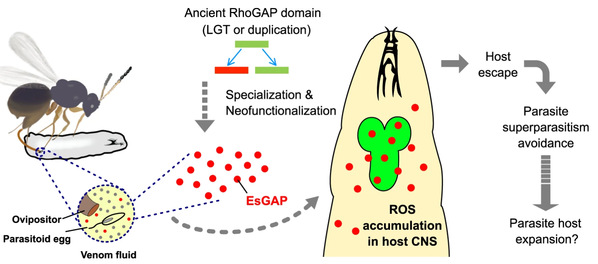Parasitic wasps are natural enemies for effective control over the population of pests in nature. Hence, they are extensively used as green agents of pest control in agriculture and forestry. There are a diversity of parasitic wasps, which have assorted parasitic habits. In general, parasitism can be divided into three types: solitary parasitism, gregarious parasitism and synparasitism. Superparasitism—two or more eggs being laid into a single host by one or more parasitoid females—usually leads to intraspecific or interspecific competition, which is thus a waste of parasitic resource. Superparasitism avoidance has captured immense attention among biologists both at home and abroad, but the underlying mechanism remains obscure.
The team led by Prof. CHEN Xuexin and Prof. HUANG Jianhua from the Zhejiang University College of Agriculture and Biotechnology worked in partnership with the team led by researcher ZHAN Shuai from the CAS Center for Excellence in Molecular Plant Sciences to conduct research into how parasitic wasps manipulate their host behavior to avoid intraspecific competition. Their research findings were published in an article titled “Neofunctionalization of an ancient domain allows parasites to avoid intraspecific competition by manipulating host behaviour” in the journal Nature Communications on September 16.

The proposed evolutionary scenario of superparasitism avoidance in Leptopilina
Leptopilina genus has some important parasitoid wasps of soft fruit pests, including some Drosophila species. Researchers discovered that two closely related species of Leptopilina—L. boulardi and L. heterotoma—are characterized by superparasitism avoidance. Therefore, these two parasitic systems are the ideal model for exploring the avoidance of intraspecific competition among parasitoid wasps. They first found that Leptopilina parasitism is often accompanied by the host escape response. By comparing escaped and non-escaped hosts, they detected noticeable superparasitism among non-escaped, i.e. they often had multiple parasitic eggs in their bodies, suggesting that host escape is a strategy that helps parasitoid wasps avoid intraspecific competition. It was further found that all escaped hosts had eggs laid and venom protein injected by the parasitoid wasps. By combining multi-omics data, researchers characterized a small set of RhoGAP genes (termed as Escape-related genes with a GtPase Activating Protein domain—EsGAP) that mediate the parasite’s manipulation of host escape by inducing reactive oxygen species in the host central nervous system. Functional studies revealed that this family of proteins can cause elevated levels of reactive oxygen species (ROS) in the central nervous system of the host larvae, thereby leading to the host escape behavior. The study finally traced the origin and evolution of such EsGAP genes and found that the RhoGAP structural domain, which is pervasive in eukaryotes, has evolved in a large number of independent replication events, and one of its branches is recruited and eventually specialized into a venom gland-specific expression gene by Leptopilina, fulfilling a new function in regulating host behavior.
“We have identified a parasitic strategy of Leptopilina in regulating host behavior, thus avoiding intraspecific competition and elucidating the involvement of EsGAP in manipulating host escape behavior at the molecular level,” said Prof. Chen. “We have also proposed a new theory regarding how avoidance of superparasitism and intraspecific competition promotes population differentiation and host expansion among parasitoid wasps. These research findings contribute to a perspicacious understanding of the molecular mechanism of superparasitism avoidance in parasitoid wasps and provide a theoretical basis for enhancing the potential effect of parasitoid wasps in biological control.”
(From: ZJU NEWSROOM)

